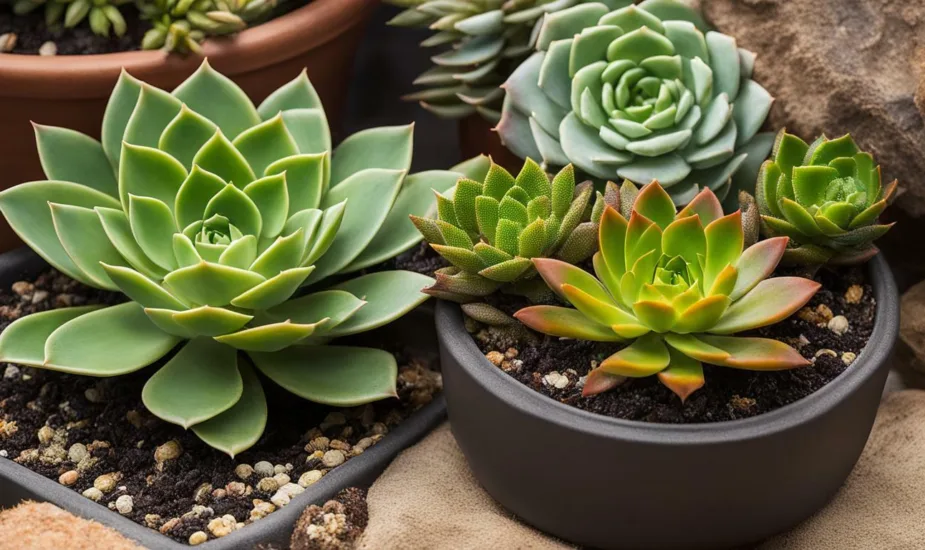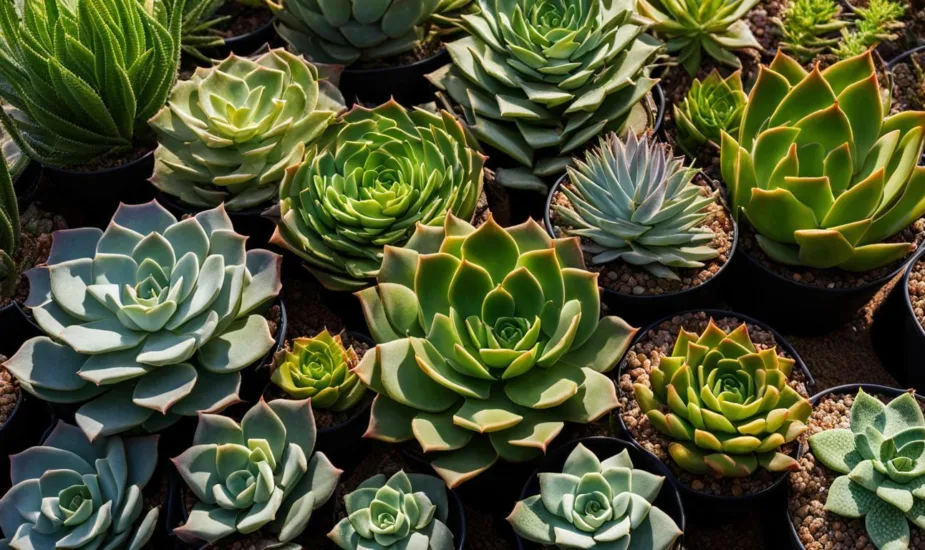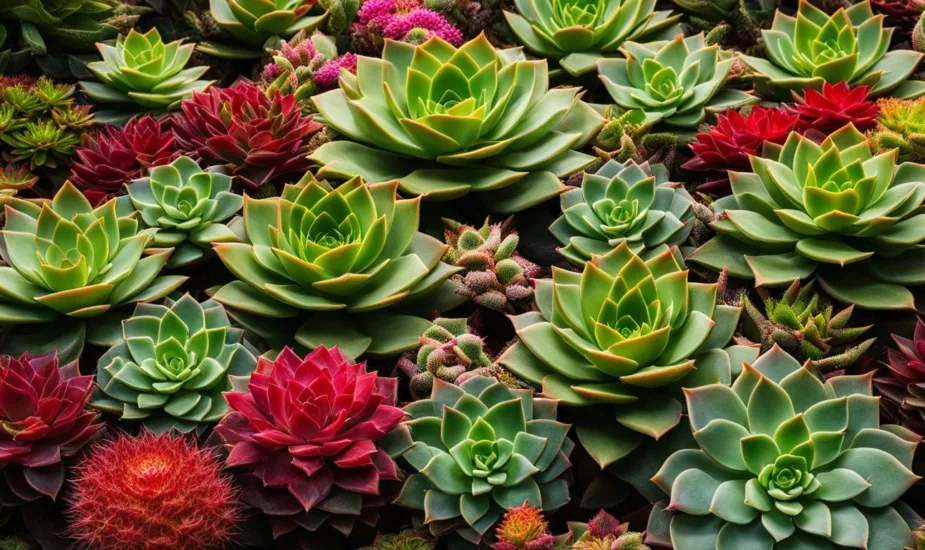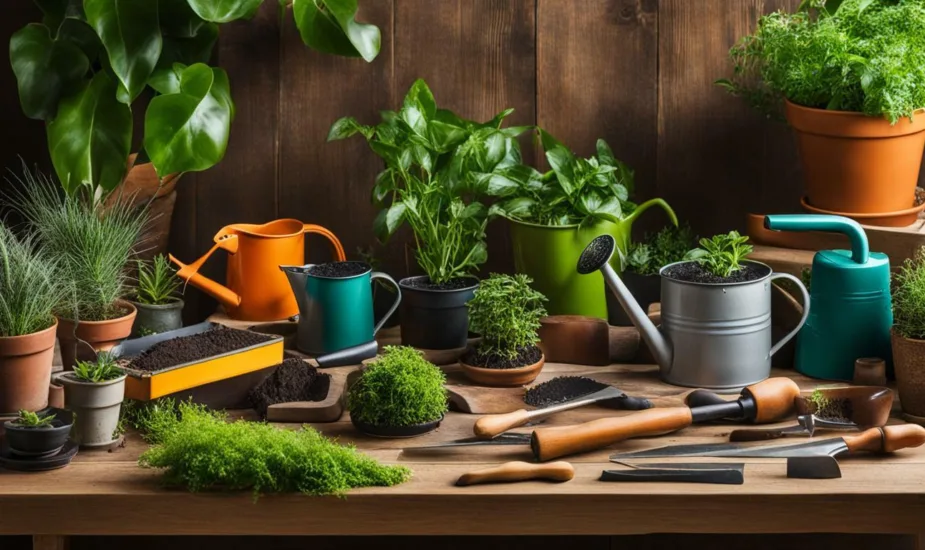Top 8 Fastest Growing Fruits: The Ultimate List for Beginners

Are you curious about what is the fastest growing fruit? Look no further! In this article, I will uncover the top 8 quickest to grow fruits perfect for beginners in the USA.
Key Takeaways:
- Blueberries, peaches, raspberries, apples, passion fruit, strawberries, lemons, figs, and mulberries are among the fastest growing fruits.
- These fruits are easy to grow and require minimal maintenance.
- They can be grown in containers or in the ground, depending on the variety.
- Proper sunlight, well-drained soil, and regular watering are essential for successful fruit growth.
- Fast-growing fruits provide a bountiful harvest within a year or two after planting.
Now, let’s dive into the details of each of these fast-growing fruits and learn how you can grow them successfully!
1. Blueberries – Fastest Growing Fruit and Easy to Grow

Blueberry plants are among the fastest fruits to grow, making them a perfect choice for beginners. With the right conditions and care, you can enjoy a bountiful harvest in just a few months. These perennial bushes thrive in acidic soil and require a sunny spot in the garden. While they can tolerate some shade, they produce the most fruit when grown in full sun.
If you have limited space, don’t worry! Blueberries can even be grown in containers. Just make sure to use acidic potting soil and provide adequate drainage. One important thing to note is that most blueberries require another variety nearby that blooms at the same time for cross-pollination, which helps ensure a high fruit yield.
When it comes to timing, blueberries are relatively quick to bear fruit. After flowering, it typically takes two to four months before the berries are ready to be picked. If you recently planted your blueberry plants, you can expect the first harvest to occur within a year or two. To maximize growth and yield, it’s essential to provide proper care, including regular watering and well-timed pruning.
Blueberries are not only delicious but also packed with beneficial nutrients like antioxidants. They can be enjoyed fresh, added to smoothies, or used in a variety of recipes. Including these fast-growing fruit plants in your garden will bring beauty, health, and flavor to your outdoor space.
Benefits of Growing Blueberries
- Fast growth rate and quick harvest
- Tolerant of different soil conditions, as long as it’s acidic
- Can be grown in containers for those with limited space
- High in antioxidants and other beneficial nutrients
- Great for fresh consumption or use in various recipes
“Blueberry plants are among the fastest fruits to grow, making them a perfect choice for beginners.”
With their fast growth rate, ease of cultivation, and delicious fruit, blueberries are an excellent choice for any aspiring fruit gardener. Whether you have a spacious backyard or just a small balcony, you can enjoy the satisfaction of growing your own fresh, juicy blueberries. Start your own blueberry patch today and reap the rewards in no time!
| Fast Facts about Blueberries | |
|---|---|
| Botanical Name | Vaccinium corymbosum |
| Family | Ericaceae |
| Growth Rate | Fast |
| Soil Type | Acidic |
| Sun Exposure | Full sun to partial shade |
| Fruit Harvest Time | Two to four months after flowering |
2. Peaches – Ripe Fruit in Just a Year or Two
If you’re looking for quick results, peaches are one of the fastest growing fruit trees you can plant. With the right care, you’ll be picking juicy, ripe fruit in just a year or two. Peaches are vigorous producers of plump, delicious fruits that can be enjoyed straight from the tree or used in a variety of recipes.
Peach trees do best in full sun, receiving at least 6 hours of direct sunlight per day. They also require good airflow to prevent disease. When planting a peach tree in the ground, it’s important to surround the trunk with a ring of thick mulch to keep the soil moist and protect the tree from damage caused by mowing.
| Key Facts about Peaches | |
|---|---|
| Growing time | 1-2 years |
| Light requirement | Full sun (at least 6 hours per day) |
| Soil requirement | Well-drained soil |
| Harvest time | Midsummer to mid-fall, depending on the cultivar and Zone |
If you have space limitations or prefer container gardening, dwarf peach tree varieties are available that can be grown in pots. Just make sure to choose a suitable container with good drainage. Dwarf peach trees offer the added advantage of being more manageable in size, making them easier to care for and harvest.
Caring for peach trees involves regular watering, especially during dry spells, and occasional fertilizing to ensure healthy growth and abundant fruit production. Pruning is also important to maintain the tree’s shape and promote airflow.
With their fast growth and delicious fruit, peaches are a rewarding choice for any fruit garden. Whether you’re a beginner or an experienced gardener, planting a peach tree can bring you the satisfaction of picking your own homegrown, flavorful fruit in just a year or two.
Tip: Choosing the Right Peach Variety
When selecting a peach variety to plant, consider factors such as chill hours and disease resistance. Chill hours refer to the number of hours below 45°F that a peach tree needs to produce fruit. If you live in a region with mild winters, choose a low-chill variety. Disease-resistant varieties can help reduce the risk of common peach tree diseases, such as peach leaf curl and brown rot.
3. Raspberries – Easy and Abundant Fruit Production

Raspberries are one of the easiest fruits to grow, and they are known for their rapid growth and abundant fruit production. Whether you choose summer-bearing or fall-bearing varieties, you’ll be enjoying a harvest in no time.
One of the best things about raspberries is their versatility in terms of growth. They can be grown in the ground or in containers, making them suitable for gardens of all sizes. When planting raspberries, it’s important to choose the right type for your climate and growing conditions.
According to a source by Kritsada Panichgul, raspberries come in two categories: summer bearing and fall bearing. Summer-bearing raspberries produce fruit on second-year canes, while fall-bearing raspberries produce fruit on first-year canes. By planting a combination of both types, you can enjoy a continuous supply of raspberries throughout the growing season. Raspberries are vigorous growers and will produce runners that spread and fill up a bed. If space is a constraint, you can even grow them in containers.
Benefits of Growing Raspberries
- Rapid growth: Raspberries can grow quickly, allowing you to enjoy a bountiful harvest within a short period of time.
- Abundant fruit production: Raspberries are known for their generous fruit yield, providing you with plenty of berries to enjoy.
- Easy cultivation: Raspberries are relatively low-maintenance and can thrive in a variety of growing conditions.
- Versatility: Raspberries can be grown in the ground or in containers, making them suitable for gardens of all sizes.
In conclusion, raspberries are a fantastic choice for any beginner gardener looking to grow their own fruit. With their rapid growth and abundant fruit production, they offer a rewarding experience and a delicious harvest. Whether you choose summer-bearing or fall-bearing varieties, raspberries are sure to delight with their sweet and tangy flavor. So why not start growing your own raspberries today and enjoy the fruits of your labor?
4. Apples – Widely Adapted and Fruitful Trees

Apple trees are the most widely adapted of all temperate-zone fruit trees, and they offer a rapid growth rate and plentiful fruit. With a little patience and care, you’ll have a bountiful apple harvest in just a few years.
These easy-to-grow fruit trees thrive in full sun and well-drained soil. They are remarkably adaptable, able to withstand a variety of climates and soil conditions. Whether you have a large backyard or a small balcony, you can find a suitable apple tree variety for your space.
When choosing an apple tree, consider the rootstock and variety that best suits your needs. Dwarf varieties are ideal for smaller spaces and can even be grown in containers. Semi-dwarf and standard apple trees can reach a larger size and produce a higher yield.
| Variety | Rootstock | Maturity | Fruit |
|---|---|---|---|
| Gala | M7 | September | Crisp and sweet |
| Golden Delicious | M26 | October | Mild and juicy |
| Granny Smith | MM111 | October | Tart and crisp |
Proper care and maintenance are essential for the success of your apple tree. Prune the tree annually in late winter or early spring to encourage healthy growth and fruit production. Regular watering, especially during dry periods, and fertilizing with a balanced fertilizer will keep your apple tree thriving.
By choosing the right apple tree variety for your space and providing proper care, you can enjoy a rewarding harvest of delicious apples each year. From homemade apple pies to fresh apple sauce, the possibilities are endless with these versatile and fruitful trees.
5. Passion Fruit – Tropical Vines for Quick Harvest

Passion fruit vines are not only beautiful but also among the fastest growing fruits you can cultivate. These tropical vines will reward you with delicious fruit in just a year to a year and a half. With their vigorous growth and quick harvest time, passion fruit vines are a popular choice for gardeners looking to add a touch of the tropics to their backyard.
Passion fruit vines are known for their rapid growth rate, often reaching lengths of up to 20 feet or more in just a few months. Their large, lush leaves and vibrant flowers add a stunning aesthetic to any garden. The fruit itself is small and round, with a hard outer shell that protects the sweet, tangy pulp inside. Passion fruit is not only delicious but also packed with essential nutrients, including vitamin C, fiber, and antioxidants.
Benefits of Growing Passion Fruit
- Fast growth rate: Passion fruit vines can quickly cover trellises, fences, or arbors, providing shade and privacy in a short amount of time.
- Abundant harvest: These vines produce a high yield of fruit, with each plant producing up to 200 fruits per year.
- Low maintenance: Passion fruit vines are relatively easy to care for, requiring minimal pruning and regular watering.
- Adaptable to various climates: While passion fruit thrives in tropical and subtropical regions, certain varieties can also be grown in cooler climates with proper care.
If you’re considering growing passion fruit, be sure to choose a variety that is well-suited to your climate. Some popular varieties include the purple passion fruit (Passiflora edulis) and the yellow passion fruit (Passiflora edulis f. flavicarpa). These vines prefer full sun and well-drained soil, so make sure to provide them with a sunny spot in your garden.
In conclusion, if you’re looking for a fast-growing fruit that will add beauty to your garden and provide you with a delicious harvest, consider growing passion fruit vines. With their rapid growth rate, abundant fruit production, and low maintenance requirements, these tropical vines are a great addition to any garden. Start cultivating passion fruit today and enjoy the sweet rewards in no time!
| Variety | Growth Rate | Harvest Time |
|---|---|---|
| Purple Passion Fruit (Passiflora edulis) | Fast | 1 year to 1.5 years |
| Yellow Passion Fruit (Passiflora edulis f. flavicarpa) | Fast | 1 year to 1.5 years |
6. Strawberries – Easy and Abundant Berries

Strawberries are one of the quickest growing fruits and are perfect for beginners. With proper care and attention, you can enjoy a plentiful harvest of delicious berries in just a year after planting. These easy-to-grow fruits thrive in full sun and well-drained soil, making them suitable for growing in gardens, raised beds, or containers.
There are various varieties of strawberries to choose from, including June-bearing strawberries and everbearing strawberries. June-bearing strawberries produce a bountiful crop in late spring to early summer, while everbearing strawberries offer multiple harvests throughout the growing season. Whether you prefer a concentrated harvest or a continuous supply of strawberries, there’s a variety to suit your needs.
One essential step in growing strawberries is to brave the removal of flowers during the first year. This allows the plants to establish a robust root system, resulting in a higher yield in subsequent years. Regular watering is crucial to keep the soil consistently moist, as strawberries have shallow root systems that can quickly dry out.
To maximize the growth and health of your strawberry plants, consider incorporating organic matter, such as compost or aged manure, into the soil before planting. Mulching around the plants helps to retain moisture, suppress weeds, and protect the berries from direct contact with the soil.
Enjoying a bountiful harvest of strawberries is a rewarding experience for any gardener. Whether used in desserts, jams, or enjoyed fresh, strawberries provide a burst of sweet-tart flavor and a boost of essential nutrients. So start growing these easy and abundant berries today and reap the delicious rewards!
| Variety | Growth Habit | Harvest Time |
|---|---|---|
| June-bearing | Produces a concentrated harvest | Late spring to early summer |
| Everbearing | Offers multiple harvests | Throughout the growing season |
“With proper care and attention, you can enjoy a plentiful harvest of delicious strawberries in just a year after planting.”
Here are some tips for growing strawberries:
- Choose a sunny spot with well-drained soil.
- Remove flowers during the first year to promote root development.
- Water regularly to keep the soil consistently moist.
- Incorporate organic matter into the soil before planting.
- Mulch around the plants to retain moisture and suppress weeds.
7. Lemons – Fast-Producing Citrus Trees

Lemons are known for their fast growth and abundant fruit production, making them a popular choice among fruit growers. With the right conditions and care, you can enjoy a harvest of tangy lemons in just a few years.
Lemon trees are relatively easy to grow and can be cultivated in containers or planted directly in the ground. They require full sun and well-draining soil to thrive. Lemons also prefer a slightly acidic soil pH, so it’s important to monitor the pH levels and make adjustments if needed.
To ensure rapid growth and maximum fruit yield, lemon trees should be properly fertilized. Use a citrus-specific fertilizer and apply it according to the instructions. Regular pruning is also important to maintain a manageable size and promote healthy growth. Prune away any dead or diseased branches, as well as any branches that are crossing or rubbing against each other.
Lemon Tree Care Tips:
- Plant lemon trees in a sunny location with well-draining soil.
- Maintain a slightly acidic soil pH.
- Fertilize regularly with a citrus-specific fertilizer.
- Prune regularly to remove dead or diseased branches and maintain shape.
- Water consistently, but avoid overwatering as lemons prefer slightly dry conditions.
“Lemons are not only delicious but also packed with vitamin C and antioxidants, making them a nutritious addition to your diet,” says Jane, a passionate fruit grower.
“I love growing lemons because they are fast-growing and provide a bountiful harvest. Plus, there’s nothing quite like the taste of freshly squeezed lemon juice in your favorite recipes or a refreshing glass of lemonade on a hot summer day. It’s definitely worth the effort!”
| Lemon Tree Care Requirements | Description |
|---|---|
| Sunlight | Full sun |
| Soil pH | Slightly acidic (pH 5.5 to 6.5) |
| Fertilizer | Citrus-specific fertilizer, applied according to instructions |
| Pruning | Regular pruning to remove dead or diseased branches and maintain shape |
| Watering | Consistent watering, with slightly dry conditions preferred |
In summary, lemons are fast-producing citrus trees that are easy to grow and provide a plentiful harvest. By following the proper care tips and providing the right conditions, you can enjoy an abundance of tangy lemons in just a few years. Whether you use them in cooking, baking, or simply enjoy them as a refreshing beverage, lemons are a versatile and rewarding fruit to grow.
8. Figs – Easy-Growing and Delicious Fruits

Figs are not only easy to grow but also offer rapid growth and delicious fruits. Whether you grow them in containers or in the ground, you’ll be enjoying the sweet taste of fresh figs in no time.
One of the great advantages of growing figs is their adaptability. They can be grown in various climates and soil types, making them a versatile choice for gardeners. Figs are also known for their rapid growth rate, often reaching maturity and bearing fruit within a few years.
To grow figs, choose a sunny location with well-draining soil. Figs can be planted in containers or directly in the ground, and they will thrive in both scenarios. They require regular watering, especially during hot and dry periods. Pruning is minimal, mainly to remove dead or damaged branches and to shape the tree.
When it comes to fig varieties, there are many options to choose from. Common varieties include Brown Turkey, Celeste, and Black Mission, each with its own unique flavor and texture. Make sure to select a variety that is suitable for your climate and desired taste.
| Variety | Flavor | Ripening Time |
|---|---|---|
| Brown Turkey | Sweet and rich | Midsummer to early fall |
| Celeste | Sugar-sweet and honey-like | Mid to late summer |
| Black Mission | Deep and intense | Late summer to early fall |
Once your fig tree begins to bear fruit, you can enjoy a bountiful harvest each season. Figs can be eaten fresh, added to salads, or used in a variety of culinary creations. They also make excellent jams, preserves, and dried fruits.
Fig Growing Tips:
- Plant fig trees in a sunny location with well-draining soil
- Water regularly, especially during dry periods
- Prune dead or damaged branches and shape the tree
- Select a fig variety that is suitable for your climate and taste preferences
Figs are a delightful and rewarding fruit to grow. With their rapid growth and delicious fruits, they are a great addition to any garden. Whether you’re a beginner or an experienced gardener, you’ll find fig trees easy to care for and incredibly satisfying to harvest from. So why not give figs a try and enjoy the sweet rewards they offer?
In conclusion, growing figs is a rewarding experience. Their easy-growing nature, rapid growth rate, and delicious fruits make them a popular choice among gardeners. Whether you have limited space and grow them in containers or have a dedicated garden, fig trees are sure to bring joy and abundance. So, roll up your sleeves and start growing your own figs – you won’t be disappointed!
Conclusion
Growing your own fruit can be a rewarding and enjoyable experience, especially when you choose the fastest growing fruit varieties. With minimal effort and time, you can enjoy a plentiful harvest of delicious fruits in your own backyard. Whether you have a large garden or limited space, there are options for everyone. From berries to citrus fruits, here are some of the easiest and fastest growing fruits you can cultivate:
Blueberries – Fast and Easy to Grow
Blueberries are among the fastest fruits to grow, and they thrive in almost any garden. These perennial bushes can even be grown in containers, making them suitable for small spaces. With the right care and a sunny spot, blueberries can produce fruit just two to four months after flowering.
Peaches – Ripe Fruit in Just a Year or Two
Peach trees are known for their rapid growth and delicious fruits. By planting the right variety and providing full sun and good airflow, you can start picking ripe peaches in just a year or two. Surrounding the trunk with mulch and proper care will ensure a bountiful harvest.
Raspberries – Easy and Abundant Fruit Production
Raspberries are one of the easiest fruits to grow in the home garden. With proper selection of summer-bearing or fall-bearing varieties, you can enjoy a continuous harvest from midsummer through fall. Raspberries grow best in well-drained soil and regions with long, cold winters and cool springs.
Apples – Widely Adapted and Fruitful Trees
Apple trees are highly adaptable and can provide bushels of fruit for several families. With full sun and well-drained soil, apple trees can thrive. While you may have to wait three to five years for the first harvest, sporadic fruit may appear earlier. Dwarf apple tree varieties are also suitable for container growing.
Passion Fruit – Tropical Vines for Quick Harvest
Passion fruit vines are known for their fast growth and quick harvest. These tropical plants can be grown in containers or in sunny locations with well-drained soil. Expect to see a full harvest of delicious fruit within a year to a year-and-a-half of planting.
Strawberries – Easy and Abundant Berries
Strawberries are one of the easiest fruits to grow, and they thrive in full sun and well-drained soil. By removing flowers in the first year to establish a strong root system, you can start harvesting strawberries the following year. With proper care, these plants can yield abundant berries.
Lemons – Fast-Producing Citrus Trees
Lemons are fast-producing citrus trees that are highly recognizable and widely used. While standard lemon trees can reach over 20 feet high, dwarf varieties are suitable for container growing. Regular pruning is necessary to maintain a small size for easy harvest. Lemons grow best in areas with long, warm growing seasons and less humidity.
Figs – Easy-Growing and Delicious Fruits
Figs are easy to grow and produce delicious fruits. They are adaptable to both containers and the ground, and they even regenerate if they freeze to the ground. Figs prefer long, hot, dry summers, but they can also be grown in pots and enjoy being root-bound. The fruits must ripen on the tree before harvesting for the best flavor.
By choosing these fastest growing fruits, you can enjoy fresh, homegrown produce with minimal effort. Whether you have a green thumb or are a beginner gardener, these fruits offer a satisfying experience and a bountiful harvest. So why not start growing your own fruit today?
FAQ
Q: What are the fastest growing fruits for beginners?
A: The fastest growing fruits for beginners include blueberries, peaches, raspberries, apples, passion fruit, strawberries, lemons, figs, and more.
Q: Are blueberry plants easy to grow?
A: Yes, blueberry plants are easy to grow as long as they have acidic soil and a sunny spot. They can even be grown in containers.
Q: How long does it take for peaches to ripen?
A: With the right care, peaches can be ready to pick in just a year or two after planting.
Q: What are the different types of raspberries?
A: Raspberries come in two categories: summer bearing and fall bearing. They grow best in regions with long, cold winters and a long, cool spring.
Q: Can apples be grown in containers?
A: Yes, apple trees can be grown in containers, especially dwarf varieties.
Q: How long does it take for passion fruit vines to produce fruit?
A: Passion fruit vines can produce a full harvest of fruit in just a year to a year and a half.
Q: Are strawberries easy to grow?
A: Yes, strawberries are one of the easiest fruits to grow, as long as they have full sun and well-drained soil.
Q: Do lemon trees produce fruit quickly?
A: Yes, lemon trees are fast-producing fruit trees, and they can even be grown in containers.
Q: How easy are fig trees to grow?
A: Fig trees are easy to grow and can be grown in containers. They are also resilient and can regrow if they freeze to the ground.
Q: What are the benefits of growing these fastest growing fruits?
A: The benefits of growing these fastest growing fruits include being able to enjoy fresh, homegrown fruit in a short amount of time and the satisfaction of growing your own food.
 Little Garden Tips
Little Garden Tips












